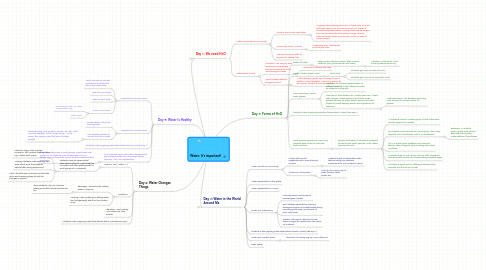
1. Day 1: We need H2O
1.1. Water is important in community
1.1.1. Plants in community need water
1.1.1.1. Ongoing observation/experiment: 2 flower pots. One will get water daily (circle time) and one will not. Students conduct daily observations, making notes and drawings in their journals about how the plants change. Teacher takes and posts digital pictures over course of week to show changes
1.1.2. Community visitor: Fireman
1.1.2.1. Imaginative play: Add fireman props to play area
1.1.3. Writing: Thank you letter to Fireman for visiting class
1.2. Water keeps us cool
1.2.1. Literature: Wet Dog! by Elise Broachman (w/repeating text and movements) to be read throughout week
1.2.1.1. Add props to literacy play area
1.2.2. Squirt bottles added to playground time
1.2.2.1. Math extension: grown-ups in charge of squirt bottles. Prompt students "How many squirts do you want?" Student to provide number
2. Day 3: Water in the World Around Me
2.1. Water around our community
2.1.1. Nature walk around neighborhood or around school campus
2.1.1.1. Measure length of observable water features using non-standard measurements, such as feet or hands
2.1.2. Where can I find water?
2.1.2.1. Look at community map of water features-lakes, ponds, etc.
2.2. Water represented on the globe
2.3. Water represented on a map
2.4. Studio art: Watercolors
2.4.1. Class discussion and review of bodies/types of water
2.4.2. Each student responds by making a watercolor picture of himself/herself doing something with water (ie at beach, at pool, with hose)
2.4.3. Teacher calls special attention to how water changes the watercolors into useful art materials
2.5. Students make ongoing notes/observations about 2 plants (See Day 1)
2.6. Water and Weather (Rain)
2.6.1. Literature: The Rainy Day by Anna Milbourne
2.7. water safety
3. Day 4: Water Changes Things
3.1. Science: This + water = ?
3.1.1. Students conduct experiments/ observations about a material before (no water) and after (adding water) in small groups of 3-5 students
3.1.1.1. Materials: sugar cube, sponge, cornstarch, dirt, quarter, bread, plastic cup, rubber duck, paper
3.1.1.2. Writing: Students make drawings and write about what they observe before/after during experiment
3.1.1.3. Math: Students use measurement tools like rulers and measuring tape to look for changes in objects
3.2. Snacktime
3.2.1. Beverage: Mix koolaid by adding water as a group
3.2.1.1. Show students "dry ice" (Discuss safety) and add to koolaid pitcher for fun
3.2.2. Cooking: make pudding by adding water (and refrigerating) about an hour before snack
3.3. Literature: I Get Wet! by Vicki Cobb and Julia Gordon
3.4. Students make ongoing notes/observations about 2 plants (See Day 1)
4. Day 5: Water Is Healthy
4.1. Important for human survival
4.1.1. World Around Us: Pictures and stories of places that don't have clean water
4.1.2. Water for your body
4.1.3. Water for your teeth
4.1.4. Water conservation
4.1.4.1. Community visitor: Az Water Conservation Org.
4.1.4.2. water cycle
4.2. Important for animal survival
4.2.1. Shows photos of animals drinking water
4.2.2. Discuss/show photos of animals that live in water
4.2.2.1. Literature/Song: Pop-up Book "Ocean" by Jack Tickle (Use with adapted "In the Jungle Song"....In the Ocean, the mighty ocean the (animal) sleeps tonight)
4.3. Students make ongoing notes/observations about 2 plants (Day 1)
4.4. Final class discussion about what happened to plant without water from daily observations (See Day 1 for more explanation)
4.4.1. Super-Scientists share in small groups. Class breaks into groups of 4-5 students. Each student gets a turn in special chair to share their journal from the week and take questions
5. Day 2: Forms of H2O
5.1. Bodies of water
5.1.1. Types: Rivers, streams, ponds, lakes, oceans, waterfall, pool (show pictures and video)
5.1.1.1. Literature: In the Small, Small Pond by Denise Flemming
5.2. States of water (liquid, solid)
5.2.1. Snack-time
5.2.1.1. Students get a cup of water at snack
5.2.1.2. Students get a cup of ice chips with snack
5.3. Music Discovery: Tuned water glasses
5.3.1. Have one set of tuned glasses (water at different levels to create different sounds) for students to play with
5.3.2. Have two or three stations for "Create your own" tuned water glasses. These stations should have water glasses, pitchers for water, towels, spoons and other objects to create tapping sound, and a grown-up to supervise
5.3.2.1. Math experience: Use standard measuring cups as props to measure water for glasses
5.4. Students make ongoing observation/notes about 2 plants (See Day 1)
5.5. Math/Science experience: How many (objects) does it take to make this bowl overflow?
5.5.1. Teacher has bowls full of water and objects to add to each bowl (pennies, unifix cubes, bouncy balls, etc).
5.5.1.1. (1) Students meet as a whole group to look at the bowl and the object to be added
5.5.1.2. (2) Students make estimate as a small group "how many (objects) until it overflows? Write # on whiteboard
5.5.1.2.1. extension: As a whole group, graph each group's estimate and compare, make additional hypotheses
5.5.1.3. (3) As a whole group students count aloud as teacher adds in objects. Stop counting when bowl overflows.
5.5.1.4. (4) Students go to small group, discuss what happened, and record the number on corresponding clipboard paper
5.5.1.5. (5) Students figure out the difference between their estimate and the actual number.
